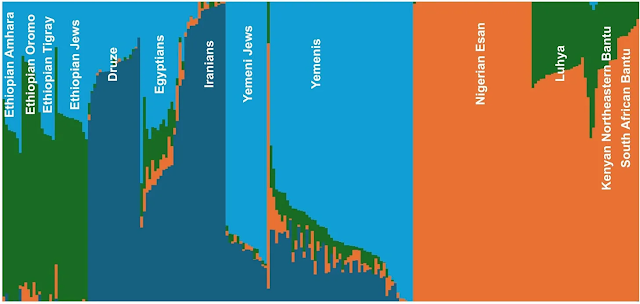Razib Khan has a new piece out on Ethiopian genetics in which he analyzes a sample of modern whole genomes and compares those from Ethiopia with those from elsewhere.
Bottom line: Ethiopian genetics are distinct both from sub-Saharan Bantus, Pygmies and Khoi-San, and from the people of the Levant and Southern Europe.
Standardized genetic distance from Ethiopia’s cultural and historically dominant Amhara people.
In a four population ancestry analysis model, Ethiopians have significant Arabian ancestry, but little Iranian or Bantu ancestry.



Archaic human remains from Hualongdong, China, and Middle Pleistocene human continuity and variation
ReplyDeleteXiu-Jie Wu, Shu-Wen Pei peishuwen@ivpp.ac.cn, Yan-Jun Cai peishuwen@ivpp.ac.cn, +15 , and Wu LiuSignificance
Human evolution through the Middle to the Late Pleistocene in East Asia has been seen as reflecting diverse groups and discontinuities vs. a continuity of form reflecting an evolving population. New Middle Pleistocene (∼300,000 y old) human remains from Hualongdong (HLD), China, provide further evidence for regional variation and the continuity of human biology through East Asian archaic humans. The HLD 6 skull is notable for its low and wide neurocranial vault and pronounced brow ridge, but less projecting face and modest chin. Along with the isolated teeth, the skull provides morphologically simple teeth with reduced or absent third molars. The remains foreshadow changes evident with modern human emergence, but primarily reinforce Old World continuity through Middle to Late Pleistocene humans.
Abstract
Middle to Late Pleistocene human evolution in East Asia has remained controversial regarding the extent of morphological continuity through archaic humans and to modern humans. Newly found ∼300,000-y-old human remains from Hualongdong (HLD), China, including a largely complete skull (HLD 6), share East Asian Middle Pleistocene (MPl) human traits of a low vault with a frontal keel (but no parietal sagittal keel or angular torus), a low and wide nasal aperture, a pronounced supraorbital torus (especially medially), a nonlevel nasal floor, and small or absent third molars. It lacks a malar incisure but has a large superior medial pterygoid tubercle. HLD 6 also exhibits a relatively flat superior face, a more vertical mandibular symphysis, a pronounced mental trigone, and simple occlusal morphology, foreshadowing modern human morphology. The HLD human fossils thus variably resemble other later MPl East Asian remains, but add to the overall variation in the sample. Their configurations, with those of other Middle and early Late Pleistocene East Asian remains, support archaic human regional continuity and provide a background to the subsequent archaic-to-modern human transition in the region.
https://www.pnas.org/doi/10.1073/pnas.1902396116
This 2019 paper is noted.
ReplyDeletewhat do you think HLD 6 is a new species ?
ReplyDeleteI don't know enough to know and I'm not sure anyone knows enough to say so confidently.
ReplyDelete